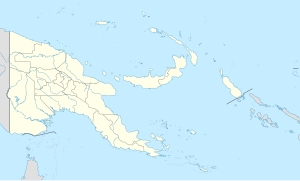Wards Airfield
| Wards Airfield 5-Mile Drome 
|
|
|---|---|
| Part of Fifth Air Force | |
|
Located near Port Moresby, Papua New Guinea |
|
| Coordinates | 09°25′48.74″S 147°10′55.53″E / 9.4302056°S 147.1820917°E |
| Type | Military airfield |
| Site information | |
| Controlled by | United States Army Air Forces |
| Site history | |
| Built | 1944 |
| In use | 1944 |
Located near Port Moresby, Papua New Guinea
Wards Airfield is a former World War II airfield near Port Moresby, Papua New Guinea. The airfield was abandoned after the war and was developed into the Waigani area of Port Moresby.
The airfield was named in honor of Australian Lt. Col. K. H. Ward, who was involved with its construction and was KIA on 27 August 1942, during the fighting at Isurava on the Kokoda Trail. It was also known as "5-Mile or 5-Mile Drome" by Americans, for its distance from Port Moresby.
Wards Airfield (Ward's Strip) was built for heavy bombers and transport planes. By 1943, it was the busiest aerodrome in the southern hemisphere. Mainly used for cargo aircraft and larger planes, Ward's was nearest to Jackson Airfield (7 Mile Drome), and at its height, its taxiways actually connected with those of 7-mile.
The major operational organization at Wards Airfield was the Headquarters, 54th Troop Carrier Wing (3 May 1943 – 18 April 1944). Operational C-47 Skytrain groups and squadrons assigned to the airfield were:
Several Reconnaissance groups were assigned to Wards to support Fifth Air Force operations:
In addition the 90th Bombardment Group also based two B-24 Liberator squadrons at the airfield.
Royal Australian Air Force units stationed at the airfield were the 9th Group, 22nd Squadron (A-20) and 30th Squadron (Beaufighter).
General Kenney's Headquarters, V Fighter Command was located at the airfield between December–January 1942. Reportedly, its cement slab foundations still remain today, located on a hill behind the airfield. A large 5th Air Force insignia and USAAF star, drawn into the concrete. Concrete steps, a garden and path that went up the ridge towards the HQ. In the 1980s traces of the paint still remained. Today, both the 5th AF logo and USAAF are partially broken, and the area is overgrown, but it still offers commanding views and an impressive remnant of the American era at the airfield.
...
Wikipedia

